.
.
photo by Ria Tafani
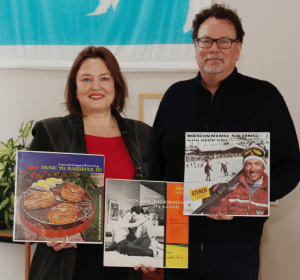
Janet Borgerson and Jonathan Schroeder, authors of Designed For Dancing: How Midcentury Records Taught America to Dance [MIT Press]
.
Ms. Borgerson is Wicklander Fellow at DePaul University. Mr. Schroeder is William A. Kern Professor in the School of Communication, Rochester Institute of Technology. They are the authors of Designed for Hi-Fi Living: The Vinyl LP in Midcentury America (MIT Press), named a best book of 2017 by the Financial Times and a best music book of 2017 by Vinyl Factory.
.
.
___
.
.
…..After forty years of playing second fiddle to cassettes and compact discs – and basically being left-for-dead – the vinyl LP is back. Now the dominant format in packaged audio media, record stores are back in vogue, offering consumers what’s left of the millions of units sold and enjoyed during vinyl’s glory days, as well as contemporary releases created by major label and independent artists alike.
…..Those of us who grew up with the LP may be perplexed by this retreat to an analog format during the digital age, but it shouldn’t be that puzzling – the sound of an LP is rich and bold, and its format conjures an appreciation for and experience with the music not typically enjoyed with a compact disc, and certainly not via a streaming service. Part of that experience is interacting with the product itself; being attracted to the art within its 12” x 12” space, reading the liner notes, and feeling a special enthusiasm for physically handling the product, setting a needle in its grooves, and settling in on the couch for 25 minutes.
…..The activity of collecting and consuming LP’s requires time and disposable income, of course, but when gems are found money becomes no object. And what makes a gem? The music, yes, but to many the album cover alone may make it desirable. Some are graphically elegant, others are pure cheesecake, but to many collectors, albums are artifacts and a soulful connection to a different American era.
Designed For Dancing: How Midcentury Records Taught America to Dance [MIT Press]
…..To Janet Borgerson and Jonathan Schroeder, collecting records is a bit of an obsession, and because their work involves studying consumer culture and marketing, they are particularly intrigued by how records impacted society.
…..In the introduction to their new book Designed For Dancing: How Midcentury Records Taught America to Dance, Borgerson and Schroeder write; “When you think about vinyl records, you might think about listening: sitting in a comfortable chair with a drink in your hand, letting the music entertain, distract, inspire. Playing a favorite record often meant selecting one from your collection, placing it on a turntable, and focusing on the music as well as on the cover and liner notes.
…..“Of course, records were also designed for dancing – a soundtrack to chasten chair dwellers and move them into motion. Records carry the grooves for all types of dancing – from square dance to samba, tango to twist, waltz to Watusi. Soundtracks for dancing but also soundtracks for dreaming, midcentury dance records offered a space for fantasy and desire – the perfect shoes, the preferred partner, the right music. Just choose the dance!”
…..The hundreds of dance records pictured and discussed in their marvelous book direct us to a time when dancing was an important social activity, and when dance records were a primary resource for learning the steps. The authors do important and entertaining work informing readers how the convergence of dancing and music – and album cover art – impacted American identity at midcentury.
…..On July 18, 2022, Borgerson and Schroeder joined me in a conversation about dance records of the 1950’s and ‘60’s – how they were conceived, produced, promoted, and connected with consumers.
.
Joe Maita
Editor/Publisher
.
.
___
.
.
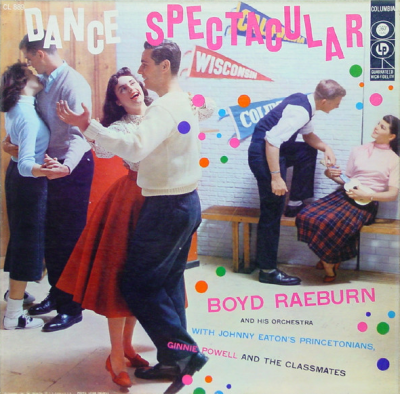
Boyd Raeburn and His Orchestra; Dance Spectacular/Columbia CL 889/1956
.
“Record albums typically find a place in popular culture rather than in fine art, but we believe that the representations of dancing found on record covers are no less evocative and telling than those in painting or photography. In looking through hundreds of mid-century dance records, we noticed that their covers, some vivid, other vapid, express the visions and vitality of social dancing. As a composite medium incorporating music, cover art, and liner notes, record albums offer multilayered sources for cultural investigation. Dance records present an overlooked aspect of visual and material culture, the media landscape, and musical practices at midcentury.”
-Janet Borgerson and Jonathan Schroeder
.
.
Listen to the 1960 recording of Rene Bloch and His Latin Dance Orchestra performing “Let’s Face the Music and Dance,” from the album Let’s Dance the Mambo [Capitol T 1455]
.
JJM In 2017 you wrote Designed For Hi-Fi Living: The Vinyl LP in Midcentury America, so this is your second book on LP cover art. How did the two of you become fascinated with this topic?
Janet During graduate school I would go to the St. Vincent DePaul shop around the corner from my house and I would just scan the record section. That would have been around 1989-1990, and there were amazing records to be found. It wasn’t necessarily the music that was attracting me, it was the wild and crazy covers, like dancers dressed in cellophane in a martini glass, or Italian dinner records, or Hawaiian albums. They were only 25 cents each, so I started bringing them home.
Jonathan We had written quite a bit together already by the time we began writing about record album covers. I teach courses in visual culture and visual communications, so this topic made sense for me, but it always felt like a backburner project. Then, about ten years ago we gave a conference talk on record album covers and midcentury design. Our colleagues encouraged us to see the potential and get more serious to the point we thought about writing a book. When we did write our first book in this area, Designed for Hi-Fi Living, we really liked the experience and wanted to keep going.

Designed For Hi-Fi Living: The Vinyl LP in Midcentury America
Janet Because we do work in consumer culture and marketing, it gives us a certain way to look at album covers. Early on I collected albums that I loved based on the colors, the font, and the wackiness of the images, and Jonathan had a selection that he’d been collecting out in Berkeley too. But once we got a sense of what the record companies were trying to sell and the marketing and graphic sense that went into it, it helped us think of this as a professional project rather than just a fun passion.
JJM I spent much of my career in the entertainment software business, and actually started in the record business in the late 1970’s, so I recognize a lot of the records you picture and write about in the book, but so many of them are new to my eyes…
Jonathan There are a lot of books on record covers, particularly well-known and celebrated jazz and rock covers, and also exotica, but we wanted to showcase musicians and covers that weren’t necessarily well-known. We didn’t want to put together the greatest hits or top dance album covers. The covers we chose reflect our experience of discovering the unknown, new music and musicians that we had never heard of.
JJM How do you define a dance record for the purpose of your book?
Examples of dance records
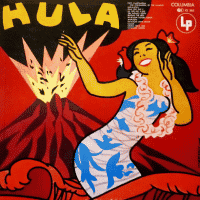
Hula/Columbia Records CL 565/1957
.
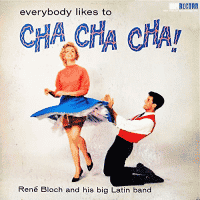
Everybody Likes to Cha Cha Cha!/HiFi R 819/1959
.
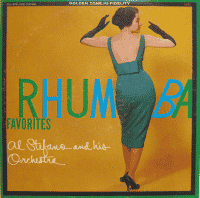
Rhumba Favorites/Golden Tone 4049/1960
.
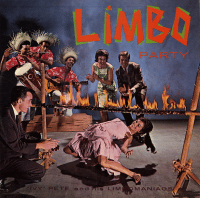
Limbo Party/Somerset SF-17600/1961
Janet Although we had hundreds and hundreds of records that we thought would be wonderful for the book – many of which didn’t get into it – we determined that any record we pictured and wrote about had to have someone dancing on the cover. There were a couple of exceptions in the chapter on the drums, but otherwise it had to show a dancer.
Jonathan After our first book, which elicited questions from readers and critics about why we did or didn’t feature certain records, so we came up with criteria for why records appear in this book. The records had to be released between 1950 and 1970. As Janet said, they needed to feature people dancing – and because we limited that to social dancing, there are no classical, ballet, or flamenco records. We didn’t include modern jazz, and we didn’t include the Charleston either because we felt like that was a little different aesthetic. And we also didn’t include disco, which is an entirely different story that also doesn’t fit into this time frame.
Janet Much of it has to do with the way we collected these records. When we finished the first book we started thinking about what would be an exciting next book. We started going through our records, and because we had so many vibrant, unusual, and wacky dance LPs, we thought that should be the topic. We had already categorized them in our record shelves, so we knew we had many records on, for example, Hawaiian dance, the Cha Cha Cha, Rhumba, and Limbo. So, from this categorization we created chapters and were on our way.
Jonathan We wanted to do a comprehensive overview of dance records because it’s something that’s never been done before.
JJM Prior to your book, if dance record covers were featured in a book, they were generally done so in a tongue-in-cheek way, and generally shown for their cheesecake quality rather than for their sociological or cultural significance.
Janet Exactly, and this was a reason why we wanted to do this book, because dance records are underestimated, and an overlooked segment – people had chortled at their designs and thought they were hysterical.
JJM Well, there are a lot of cheesecake covers, but there are also really interesting graphic designs and even line looks that I didn’t realize ever existed. So, your book was an eye opener in that regard.
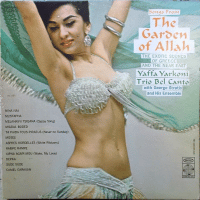
The Garden of Allah/Epic LF 18025/1963
.
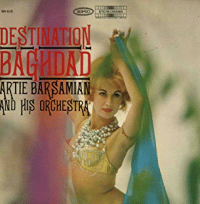
Destination Baghdad/Epic BN 618/1962
Jonathan We had decisions to make about certain categories of dance records. For example, we questioned how to handle “belly dance” records because, let’s face it, there are many cheesecake “belly dance” record album covers. But some of the dancers featured on the so-called belly dance albums were famous, and many of the musicians were earnest about their desire to introduce their music from the Middle East and Turkey to the United States, so we tried to tell stories about the people who actually played and performed on these records, and to do so from the perspective of the 1950’s and 60’s, when they were released, rather than through our 2022 lens.
Janet Because we were focused on that mid- 20th century era, the cultural aspect of immigration came in. Where were people coming from, and what kind of music did they want to listen to? And because we did take some of those “belly dance” records seriously, we learned about some oud players and dancers, and we also learned about some small record companies. So, it was a learning experience for us to understand that many of the artists featured on these “belly dance” records were well-known in their countries – they weren’t just fly-by-night hucksters backing sexy dance.
JJM There is such an international flavor to these record albums, which were released during a time that coincided with consumers’ new understanding of the safety and ease of international travel. And travel companies were marketing places like the Caribbean, which must have influenced the way record companies marketed their products, particularly these dance records…
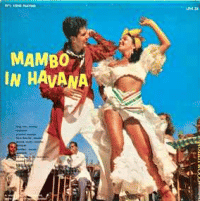
Mambo in Havana/Hollywood LPH 24/1959
Jonathan Yes, and using Caribbean music as an example, in some cases an organization like the Bahamas Tourist Agency would have supplied the photograph the record companies used for the dance records, and at times the airlines themselves would be involved in promoting the music, particularly when they were opening up new routes. Sometimes the records would be given out on cruises as a kind of memento, but also as a marketing ploy. So, there were pretty intimate connections between the marketing of the records and the marketing of tourism.
JJM Who were the early influencers of how dance was depicted on album covers?
Jonathan We went to see an exhibit of paintings in an art museum that was all about dance in visual art and painting. The exhibit’s catalog said that this was the very first look at dance and painting, and we thought that was an interesting claim.
Janet Yes, and we thought that we could use a similar claim in writing the proposal for our book, that this is the first book to look at the depiction of dance in mid-century record album covers.
Jonathan So, we spent time tracing some of the visual aspects of dance record covers, from painting to photography. It was a particular challenge for still photography; how would they show the movement of dance in a still photograph? So, the technique of multiple exposure and blurriness came into use, when the freezing of a moment became vibrant, but we as viewers knew that moment is only one of a series of moments that make up a dance movement. In the book we do make an attempt to trace dance record album covers back to other forms of visual communication.
Eadweard Muybridge, Public domain, via Wikimedia Commons
“The Horse in Motion,” by Eadweard Muybridge, 1878
Janet We discuss, for example, how the photographer Eadweard Muybridge was able to depict animals like horses and cats in motion using stop action photography, and also how he captured ballroom dancers in motion, shot by shot, cell by cell – they’re moving across the floor, her dress swirling around her feet. We were also able to find some instances of dancing in romantic paintings of Native American rituals. So, while we didn’t do a complete survey, we found album covers resonating with those art forms, and wrote about tracing early depictions of dance back to painting, sculpture and photography.
JJM You cite the Harlem Renaissance photographer James VanDerZee’s stunning shot of five young girls dancing as an example of an early depiction of picturing movement and dance…
Janet Right, jumping…
Jonathan That’s a classic photograph.
Janet When we found the album Teenagers Dance, and the dancers were bouncing in the air, Jonathan immediately said that it makes him think of that VanDerZee photograph.
.
A musical interlude…Listen to Della Reese sing “Love For Sale,” from her 1960 album Cha Cha Cha. [RCA Records]
.
JJM Who typically consumed dance records?
Jonathan That’s a big part of the story. In the late 1940’s and early 50’s, the music of the swing era jazz musicians was fading in popularity, but the record album covers show how the record companies attempted to keep their sales going. Albums were repackaged and updated with vibrant dance music covers, and some were successful, others not so much. A consumer might think they are buying a dance record of contemporary tunes – like an Elvis Presley-inflected dance record – but what they got instead was a big band playing in an up-tempo style.
Janet This idea of repackaging older music in the dance era, basically as a way to sell records, was interesting to think about, and you see it come up in a number of ways. Tito Puente, for example, would be featured on a cover with African masks, exotica font, and painted drums, all for the purpose of making the music look and seem more exciting. Some of this was directed at teenagers, and some at older couples who were used to ballroom dancing but no longer had any place to go for that. So, the question for the record companies was how to entice these people to keep buying records.
We saw this come up with singers, also. Someone like the pop jazz singer Della Reese had a Cha Cha Cha record, which was a way to suggest that her records were for dancing. It’s easy to be cynical about how this may have been a marketing ploy, but at the same time dancing was an important way to push music forward – the music was made for dancing, and the dancing, in turn, made the music.
JJM To many men, the idea of dancing can be intimidating, and I imagine that was the case for men of midcentury America. So, I presume it is safe to assume that the bulk of the consumers of dance records were women?
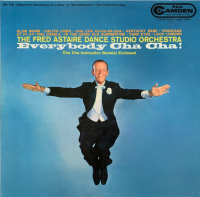
Everybody Cha Cha! Fred Astaire Studio Orchestra/RCA Camden CAS 476/1959
Jonathan A lot of the dance records – including instructional records by the likes of Arthur Murray and Fred Astaire – were marketed to women, and part of the idea was to learn dance steps prior to an event like a wedding or a party. Many of the dances were of course for couples, but a dance like the Twist became popular partly because you could dance that step alone – you didn’t need a partner.
Janet Some of the record album covers would evoke places like New York City or Kansas City – larger urban areas where there were dance halls – and in some sense the men and women are pictured as being equally competitive. Men who had a hard time being seen as a dancer could be seen as a gymnast, or an athlete in some way because some of the dancing was so energetic and taxing, and people would practice and practice to get their moves right. So, if we’re talking about urban area ballrooms, the men and women were likely to be equally interested in dancing because it was a way to show off and compete. And in smaller towns you could be part of a dance club. Jonathan’s parents and mine belonged to a dance club. They’d attend every couple of months – hire a band, decorate a location, everyone would dress up, eat dinner, and dance all night long. People in small towns would likely need to go to an Arthur Murray dance class to learn some of these dance steps so when the music came on they could hit the dance floor.
JJM And dancing wasn’t just for romance, it was a form of social networking…
Jonathan Yes, dancing was seen as an important social skill, and provided people with a social presence, poise and confidence. And that’s a big part of the way some of these dance records were being marketed.
Janet Some of the earliest Arthur Murray dance books we were able to find focused on upping your social status through dancing.
JJM How influential was Arthur Murray?
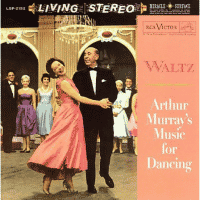
Arthur Murray’s Music For Dancing (Waltz)/RCA LSP 2153/1959
.
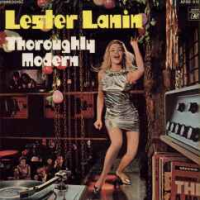
Thoroughly Modern; Lester Lanin/Audio Fidelity ASD 6180/1968
Jonathan He was very influential as a dance instructor, but also as a businessman. The Arthur Murray Dance Studios was one of the first successful franchise businesses in the United States, and at one point they had about 3,500 studios. He was a very savvy marketer – he had a multi-tiered marketing plan to get his name out there that included his dance studios, he sold his records, and he also had a television show along with his wife Catherine. In today’s world he might be considered an “influencer.”
JJM These dance records were being produced and distributed during post-war America, and a time when the long playing record album had become a staple of home entertainment. How did these dance records contribute to this transformational era in America?
Janet The musicians who played in dance bands in clubs and in ballrooms were quite distressed that people might listen to their music on record and maybe not come out to a live band. But it was also a time when someone like the bandleader Lester Lanin, who was a master marketer, could transform his career by playing in private homes for events like graduations and weddings, made possible by the exposure from his record albums. This movement of entertainment into the private household was part of the mid-20th Century migration of people from the cities to the suburbs, where homes had their own recreation rooms and backyard patios. They could have their own luau party. So, you can start to see some of the loss of the public sphere – the communal getting together – as soon as a technology came along that allowed people to be more isolated in their home.
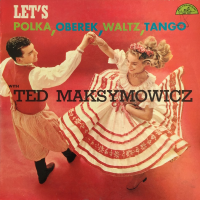
Let’s Polka, Oberek, Waltz, Tango/ABC Paramount 229/1958
.
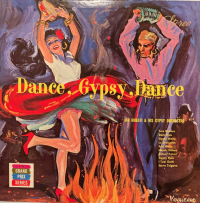
Dance, Gypsy, Dance/Bravo K 135/c. 1960
.
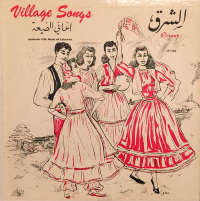
Village Songs: Authentic Folk Music of Lebanon/Orient LP-108/1961
Jonathan One of the themes we try to develop in the book is how dance and dance records in particular tell a story of American identity. “Ethnic” music like folk music, polka, Greek dancing, and “belly dancing” was an important way for immigrants new to America to show their roots to their new neighbors. Record albums also addressed the issue of race and class. Who dances to a waltz versus who dances to rock ‘n roll? The roots of today’s identity politics can be seen on these record covers, especially in terms of the changing fads and fashions of dance.
Janet Yes, and racial boundaries were super strong at the time, but the dance floor could be a place – if they went to the right dance club – where racial mixing was tolerated. Other clubs worked hard to keep people racially separated, and this was continued by some of the dancers themselves. Some of the clubs were specific about only playing a certain kind of music in hopes of keeping certain kinds of rhythms and the hip movements they inspire off their dance floor. But other dance clubs allowed that, and people got to know each and learned about each other. It’s an interesting boundary that dancing played a major role in, both preserving and breaking down.
JJM You wrote in the book that “dance allows a chance to alter the concept of ‘self’ and understand the ‘other.’” How did record companies approach interracial issues? For example, were integrated couples ever featured on album covers?
Jonathan There are a couple of album covers that show a mixed dance floor, and there is some mixing of the white and Latin culture on Tango records, one of which shows what appears to be a Latin dancer expertly showing a white man’s wife or girlfriend how to Tango. The white guy is shown sitting alone at the table, sulking, left out.
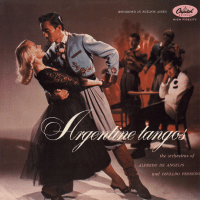
Argentine Tangos/Capitol T 10053/1957
.

Calypso For Dancing/Epic LN 3348/1957
Janet Yes, that’s Argentine Tango. There is another great example, a Calypso record, where the “natives”, the islanders, are dancing in a club-like setting, expressive faces, midriffs and legs exposed, and the white couple in formal dress sort of clinging together are hidden behind them all – most you see of them is a high-heeled shoe and a martini on the floor, suggesting that they had to be drinking to get out on the floor, to do that kind of dancing. But record companies played to both audiences as best they could. If they felt they had consumers who didn’t want images of racial mixing on their album covers, then they wouldn’t do it. But, if they thought they could market to an audience more amenable to interracial images, they would do so on another one of their labels. They went wherever the dollars were.
JJM The audience for these records must have been overwhelmingly white, and while many white consumers have a fascination with other cultures – and in this case, in dances from other parts of the world – they’ve generally wanted it tailored to them and what makes them comfortable, which of course wipes out a lot of authenticity of the culture…
Jonathan We really enjoyed learning more about Caribbean dances while we wrote this book. We have come late to learning about Latin dance, and this book gave us a chance to understand how musicians and marketers thought about this big influx of Latin music that came to American at mid-century. What did it mean to try to “dance Latin”? And how did Arthur Murray’s teachers tame the Latin dances?
Janet And the answers to those questions are not hidden. You can watch a video on YouTube that basically shows a couple dancing wild in an authentic version of a dance, and then a version of how that same dance would be taught to white people; all very upright, all very proper. They knew exactly how much “hip” they could get away with before people would get upset.
Johnston, Frances Benjamin, 1864-1952, photographer., via Wikimedia Commons
Vernon and Irene Castle, c. 1912/13
JJM There’s a history of this going back to the days of the husband and wife dance team of Vernon and Irene Castle, who refined the foxtrot and taught people how to dance to jazz music in the 1910’s. So, they were skilled at refining dance moves deemed by white people to be too risqué.
Jonathan There is a long history of dance criticism and prohibitions against dance. For example, as soon as European settlers arrived in the United States they prohibited Native American dance. This kind of attitude continues today, where certain religions prohibit any kind of dance. So, this is a very important part of the tale also.
Janet Yes, there is a long history of suppressing cultures by suppressing dance and language, of course, and also the drum. Native Americans were basically forbidden to play drums, which was also the story of the Africans who were enslaved here – their rhythm instruments were banished as part of a plan to crush their native cultures, and also potential means of communication. There is an interesting, ugly history here.
JJM No question that the way Americans presented other cultures on album covers is a disturbing part of this story. Did you find that any of the record companies made attempts at informing the consumer of the true origins of the dance?
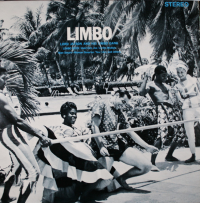
Lord Jayson and His Limbo Gang/Palace M-730/c. 1960
.
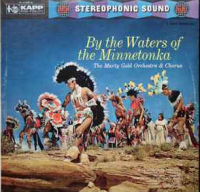
By the Waters of the Minnetonka/Kapp K-1125-S/c. 1959
Jonathan In the process of writing these two books we have tried to balance a celebration of them with an understanding that, while we like the records and have discovered fascinating aspects of them, we also have to be able to critique them, to recognize that some of them support old stereotypes that can drum up controversial issues. But one of the things important for us was to not look at the albums with a 21st century lens, and suggest that race relations, for example, weren’t addressed in some way at that time. In the liner notes of these records the subject of slavery or the suppression of the drum is often mentioned. So, we tried to view the records as archival objects, and especially use the stories that the record liner notes themselves told about dances like the Limbo, because they were fairly frank about pointing out the origins of the dance – in many cases revealing that the rhythms came from enslaved people. It is important that we honor the records, see what kind of stories they told at the time, while also giving them some contemporary context.
Janet I don’t love a lot of these records for the music, because much of the music is tiresome, but I still might love the cover, and I certainly might appreciate what’s in the liner notes. I have come to have a new respect for many of the liner notes. We might approach a record because of its goofy cover and assume it’s going to be a goofy record, and then we find a history written in the liner notes that is much more upfront about how and why these rhythms came to this country. We’ve learned to respect these records – for example, we don’t need to import a discussion of slavery to understand a Limbo record when that discussion already exists in the album liner notes themselves, and that was a great discovery.
JJM I’m always interested in a history of record companies, and while going through all the great photos of album covers within your book I couldn’t help but notice the way certain companies marketed dance records. Do you have a sense about what record company was most effective in exploiting this market?
Jonathan Tico Records comes to mind. They weren’t a very big company, but they focused on Latin music, and were very important in the transition from the Cha Cha Cha and Rhumba to Salsa. They really tried to work with the musicians in terms of the selection of the tunes and the art used on the covers, which were very compelling.
Janet In our first book we devoted an entire chapter to Columbia Records’ Adventures in Sounds series, but we didn’t include a similar chapter in the Designed for Dancing book. I would say though that if you look at companies who were effectively introducing international music to American audiences, Capitol and their Capitol of the World series did that despite being a little goofy and “pop-y” at times. Columbia’s Adventures in Sounds series did a good job of recording the music where it came from, and Riverside produced some good albums also.
.
A musical interlude…Listen to the 1957 Calypso recording of The Duke Of Iron play “Man is Easy Fish”
.
JJM One of the things that struck me was how quickly some of these record companies exploited the popularity of the music. An example that comes to mind is Calypso – made famous by Harry Belafonte’s recording of “Day-O (Banana Boat Song)” in 1956. Within a short period of time, several record companies had released Calypso dance records…
Jonathan That’s right. It’s an interesting story because if you read Billboard articles written at that time some people were thinking that Calypso was going to be the next big thing in music, to the point that it would be more popular than rock ‘n roll. Obviously that didn’t happen…
JJM It was wishful thinking, I’m sure…
Jonathan But record companies were jumping on the Calypso bandwagon…
Janet But, what I’m thinking right now is that Calypso actually did overwhelm rock ‘n roll, except now we think of it as rap, or hip hop. Rap music comes straight out of Calypso, which is the song and the rhythms and the lyric battles of Trinidad’s Carnival, so when you think about what midcentury music analysts meant by “Calypso” music, they didn’t necessarily mean ballads from a male vocalist pop musician, they meant those rhythms and vocal style. So now I’m thinking that Calypso had its revenge, because rock ‘n roll may have ruled right at that moment, but if you look at pretty much any popular music now – even country music – it is infused with rap and what could be considered Calypso. So, I’m taking a new stance on this – Calypso is the dominant music after all!
JJM Your book devotes individual chapters to dance steps like the Tango, Waltz, Rhumba, Mambo, Limbo and so many others. What dance step inspired the most recordings?
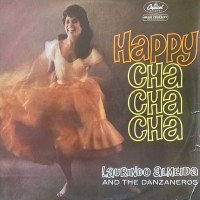
Happy Cha Cha Cha; Laurindo Almeida and the Danzaneros/Capitol T 1263/1959
.
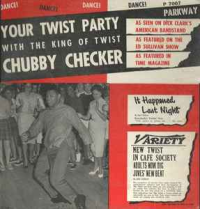
Your Twist Party With the King of Twist, Chubby Checker/Parkway P 7007/1962
.
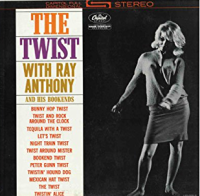
The Twist, with Ray Anthony/Capitol T 1668/1962
.
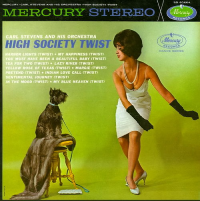
High Society Twist, Carl Stevens and His Orchestra/Mercury SR 60664/1962
Jonathan In the 1950’s it was probably Cha Cha Cha. That was known as the easiest introductory Latin dance. Everybody did the Cha Cha Cha. And then in the early 1960’s it was the Twist. Everybody put out a Twist record.
JJM I certainly remember the era of the Twist, and how appalled my parents and grandparents were about it, which is ironic since it was a dance step that didn’t require the touching of your partner. It was the hip movements that must have made the elders crazy…
Jonathan It was a profound change, the idea that people could dance by themselves, without the need of a partner, and without having to follow a prescribed choreography. They weren’t doing a dance like a Waltz or a Tango, they were just up there moving. So, the Twist was significant cultural change.
Janet Taking it back to the Twist’s theoretical, sociological, and cultural significance, this dance step occurred at mid-century, when the artistic movement was modernism, which emphasized the individual’s emotional responses and interior world. It was a movement away from a community cultural expression, and this dance allowed that kind of individual subjective guidance that made it alright for its participants to say, “I am an agent of my own body movement and I will dance the way I want to dance.”
Jonathan When you think of modernism you usually think about literature, furniture design, architecture, abstract art and, of course, jazz. The jazz musicians were improvising and playing what they felt, and that’s a classic way to think about modernism. The Twist, in a sense, fits into this modernist movement.
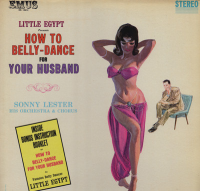
How to Belly-Dance For Your Husband/Roulette R 25202/1963
JJM While few album covers were overtly sexual, there are some interesting images that connect dancing to sex. One I find humorous is the 1963 Roulette Records album How To Belly-Dance For Your Husband, on which a woman is illustrated provocatively dancing for her husband, who is sitting in a chair, pensively posed, taking in the scene, almost as if he were a voyeur. It strongly suggests dance as foreplay…
Jonathan Yes, it was a kind of Playboy aesthetic, an image of a sexually liberated couple who would have an interest in a modern version of this ancient, seductive dance.
JJM What are some of your own personal favorite dance record album covers?
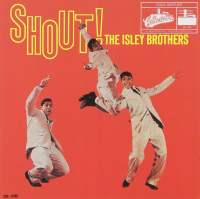
Shout; The Isley Brothers/RCA Victor LSP-2156/ 1959
.
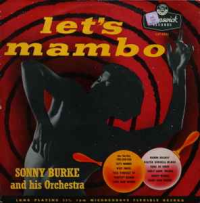
Let’s Mambo; Kenny Burke and His Orchestra/Decca DL 8090/1955
Jonathan One that I think of is The Isley Brothers’ Shout from RCA, which is just a studio photograph of the three Isley Brothers dancing exuberantly in front of a bright-red background. I love that cover.
Janet And I love the Decca record Let’s Mambo, with Sonny Burke and His Orchestra, which shows a dancer in a psychedelic, psychotic swirl, as if “Let’s Mambo” means to move into a psychotic space. The cover looks like it could be the beginning of an Alfred Hitchcock film.
Jonathan Yes, like his film Frenzy.
Janet We love so many of these album covers. We had to cut many images in order to get down to the 300 or so that are pictured in the book, and it was painful for us to let go of the ones we weren’t able to include. Another cover I love is the Epic album Calypso For Dancing, by J. C. Heard, and this one I described earlier when you asked about albums showing integrated couples. On this cover you can see a white couple among exuberant Black dancers. It is a fantastic record.
JJM What are examples of essential album covers based on the quality of their design?
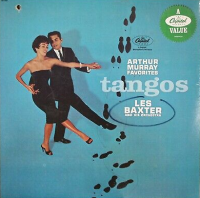
Arthur Murray Favorites; Tangos; Les Baxter and His Orchestra/Capitol M 11979/1960
.
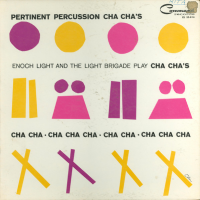
Enoch Light and the Light Brigade; Pertinent Percussion Cha Cha’s/Command RS 814SD/1960
Jonathan Some of the Arthur Murray covers are graphically elegant, and people seem to especially remember the series that pictured diagrams of the dance steps.
Janet The Designed for Dancing series on RCA Camden is interesting. Great colors. Ernest, evocative photographs. The series features the bandleader Les Baxter, but no Tiki masks or palm fronds on the covers, they are straight-up dance dates and very fun. We loved discovering that series.
Jonathan Another interesting record cover for its graphics is one from the Command record label, Enoch Light and the Light Brigade Play Cha Cha’s. It’s a modernist graphic design by an artist named Gerry Olin, a somewhat rare female cover designer, and it attracts attention because it breaks the mold – it’s much different than a typical Cha Cha record. It’s fun, abstract, and we knew we had to include it in our book.
Janet Also, people comment on an album Mary Tyler Moore was on called Latin Favorites. She was in the beginning of her movie and television career at the time.
Jonathan She had just died when we were writing the book and felt like we really should include her.
JJM What’s next for you guys? Are you doing another book on LP cover art?
Janet Yes we are, and it’s called Designed for Success.
Jonathan It’s about instructional records. It will include a couple of the dance instruction records we couldn’t fit into Designed for Dancing, in a chapter about joining in on music and dance. We also include a couple of “Music Minus One” records, which would teach people how to play an instrument and allow you to play along with the band. For example, if you were learning how to play the saxophone you hear a jazz combo playing, but without the saxophone. This series was at one time an important part of music instruction. Language records, also.
Janet Records about selling, getting ahead, Amway records…
Jonathan Several records about how to appreciate jazz and other types of music. And then there are the odd records that fit into this instructional category, like The Secrets of Successful Varmint Hunting. This guy was selling portable record players which allow you to take recordings of rabbits in distress into the wilderness with the intent of attracting coyotes and other predators. So, you either shoot them with a camera or shoot them with a gun. It was up to you!
Janet Designed for Success is about self-improvement – a “get ahead” approach that is a basic way of thinking in the United States. If you needed to learn a language prior to traveling or to get a better job, you could go out and buy a record. There are also recordings that deal with family issues, like how to teach your children the facts of life, or how to tutor your children in the new math. So, Designed for Success is about instructional, self-help record albums that could assist people in gaining new skills and becoming entrepreneurial. The covers in this book are not typically as vibrant, colorful, or exotic as in Designed for Dancing, but they have this capitalist realism that came out of post-war America during a time when the record album was the technology of choice.
.
.
“Our ‘analog rescue’ project embraces the goal of changing – or enhancing – the way people look at midcentury record covers. Bought at a local supermarket, department store, or specialty record shop and brought into the privacy of home, midcentury dance records visualized the fashions, environments, and accoutrements of dancing. Dance records provided resources for the development and expression of identity – twelve-by-twelve guides for harmonizing with the rest of the postwar nation. What could be more midcentury American than that?”
-Janet Borgerson and Jonathan Schroeder
.
.
Designed For Dancing: How Midcentury Records Taught America to Dance
[MIT Press]
by Janet Borgerson and Jonathan Schroeder
.
.
Praise for the Book
“From hula to rock and roll, belly dance to square dance, tango to Polish polka, Borgerson and Schroeder provide a treasure trove of information, research, and warm memories!”
-Anthony Shay, Professor of Dance and Cultural Studies, Pomona College
.
“Dance music LPs of all styles and nationalities were prized possessions in my family’s home, and this cover collection reminds me of the infectious sounds streaming from the record console and the joyful music that filled the air with happiness.”
-Steven Heller, cochair MFA Design, School of Visual Arts, New York
.
“Midcentury Americans sure did love that living-room shimmy. This beautifully illustrated compendium reveals the long-forgotten cosmopolitanism and playfulness of Cold War America. It also makes you want to dance. Who could ask for more?”
-Fred Turner, author of The Democratic Surround: Multimedia and American Liberalism from World War II to the Psychedelic Sixties
.
“An intriguing look at social dance culture through a material lens. For scholars and aficionados of mid-20th-century popular culture.”
–Library Journal
.
“A fascinating yet approachable read and a gorgeous feast for the eyes.”
-Christine Green/(585) Magazine
.
.
Janet Borgerson is Wicklander Fellow at DePaul University. Jonathan Schroeder is William A. Kern Professor in the School of Communication, Rochester Institute of Technology. They are the authors of Designed for Hi-Fi Living: The Vinyl LP in Midcentury America (MIT Press), named a best book of 2017 by the Financial Times and a best music book of 2017 by Vinyl Factory.
.
.
___
.
.
This interview took place on July 18, 2022, and was hosted and produced by Jerry Jazz Musician Editor/Publisher Joe Maita
.
If you enjoyed this interview, you may want to read “Cover Stories with Paul Morris.” Paul is a graphic designer and writer who collects album art of the 1940’s and 1950’s. He finds examples of influential mid-century design in the used record stores of Portland, Oregon. Click here to go to his page on Jerry Jazz Musician.
.
.
Click here to learn how to subscribe to the Jerry Jazz Musician newsletter
.
.
.




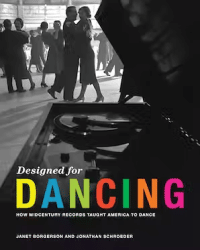


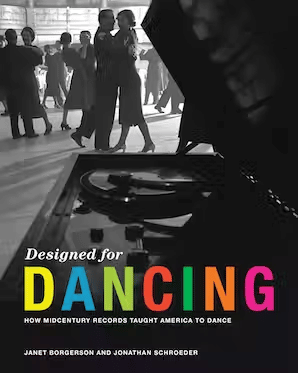



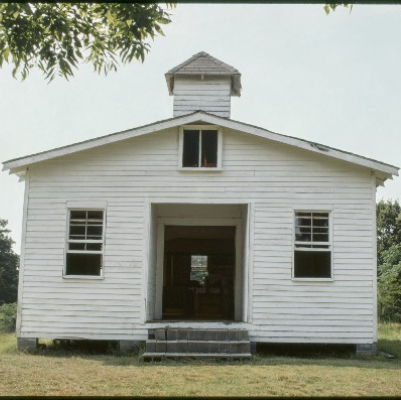
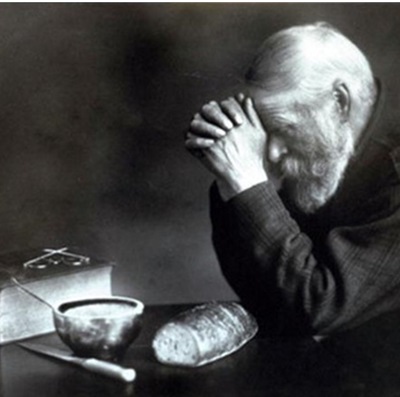















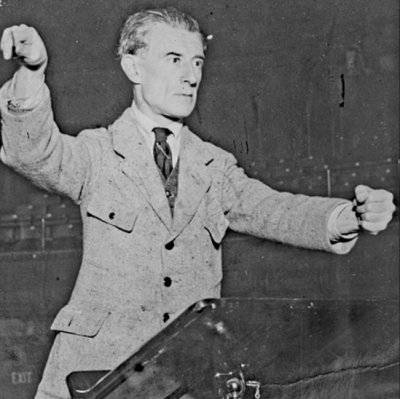





















From your mention of Ted Maksymowicz I think of the reason, as I read, why he made some of this records: to help teach the younger generation the old Polish dances, but I hav forgotten exactly what he meant by that; to wit, polka is not one of them, although all the Polam (Polish-American) bands eagerly play them, and the hearers dance to them. Oberek most certainly is, and kujawiak, too. Right after WWII Polam bands had around three really good decades; here in Toledo (long ere I moved in) there were three polkas a week, and maybe more.
By the way, Bernie Witkowski founded Stella Records because he felt that the big labels were ill-using Polam musicians and bandleaders.
I wondered what is on “Dance, Gypsy, Dance”. I looked it up on DISCOGS.COM, where it was called Gypsy Jazz (Django Reinhart?). And there was no information from the jacket beyond the bandleader s name, only advertizement on the back about other of the maker s wares. None of the titles is familiar to me, maybe only “Dark Eyes”, and, if that is the old Russ song, surely the notion of dancing is the publisher s invention. In the picture, the woman has high-heeled shoes!